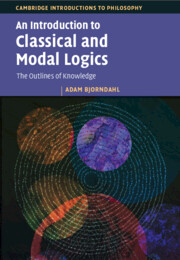Refine search
Actions for selected content:
141 results
2 - The Arts Faculty
- from Part I - Historical Context
-
-
- Book:
- The Origins of Scholasticism
- Published online:
- 18 November 2025
- Print publication:
- 31 December 2025, pp 55-88
-
- Chapter
- Export citation
4 - The Inaugurators of Scholasticism: Language and Theology in the Twelfth Century
- from Part I - Historical Context
-
-
- Book:
- The Origins of Scholasticism
- Published online:
- 18 November 2025
- Print publication:
- 31 December 2025, pp 116-154
-
- Chapter
- Export citation
7 - The Trinity
- from Part II - Theological Themes
-
-
- Book:
- The Origins of Scholasticism
- Published online:
- 18 November 2025
- Print publication:
- 31 December 2025, pp 208-236
-
- Chapter
- Export citation

The Origins of Scholasticism
- Theology and Philosophy in Paris, 1150–1250
-
- Published online:
- 18 November 2025
- Print publication:
- 08 January 2026
The teaching of logic among the Greeks in the early modern period: was there such a thing as ‘post-Byzantine philosophy’?
-
- Journal:
- Byzantine and Modern Greek Studies , First View
- Published online by Cambridge University Press:
- 12 November 2025, pp. 1-18
-
- Article
- Export citation
The ‘alternative preface’ to Theophilos Korydalleus’ Logic: a minor episode of factional intrigue in the Patriarchal School of Constantinople in the seventeenth century
-
- Journal:
- Byzantine and Modern Greek Studies , First View
- Published online by Cambridge University Press:
- 03 November 2025, pp. 1-20
-
- Article
-
- You have access
- Open access
- HTML
- Export citation
Part IV - Epilogue
-
- Book:
- Ethnography in International Business
- Published online:
- 21 October 2025
- Print publication:
- 09 October 2025, pp 237-251
-
- Chapter
- Export citation
Introduction
-
-
- Book:
- Ockham’s <i>Summa Logicae</i>
- Published online:
- 04 September 2025
- Print publication:
- 18 September 2025, pp 1-18
-
- Chapter
- Export citation
Chapter 3 - Ockham on Metalanguage
-
-
- Book:
- Ockham’s <i>Summa Logicae</i>
- Published online:
- 04 September 2025
- Print publication:
- 18 September 2025, pp 59-84
-
- Chapter
- Export citation
4 - Logical Values
- from Part I - MATLAB Programming
-
- Book:
- Foundations of MATLAB Programming for Behavioral Sciences
- Published online:
- 28 October 2025
- Print publication:
- 07 August 2025, pp 48-57
-
- Chapter
- Export citation
Chapter 9 - Why Ask Why? Retrieving Reason in Being and Time
-
-
- Book:
- Heidegger's <i>Being and Time</i>
- Published online:
- 28 June 2025
- Print publication:
- 26 June 2025, pp 177-197
-
- Chapter
- Export citation
DP AND OTHER MINIMALITIES
- Part of
-
- Journal:
- The Journal of Symbolic Logic , First View
- Published online by Cambridge University Press:
- 11 April 2025, pp. 1-30
-
- Article
- Export citation

Logic and Science
- An Exploration of Logical Anti-Exceptionalism
-
- Published online:
- 10 April 2025
- Print publication:
- 10 April 2025
-
- Element
-
- You have access
- Open access
- HTML
- Export citation
Interpreting the Qur’an through the science of logic: Ibn ʿArafah al-Warġammī (d. 803/1401) on the dynamics of tafsīr and manṭiq
-
- Journal:
- Journal of the Royal Asiatic Society / Volume 35 / Issue 2 / April 2025
- Published online by Cambridge University Press:
- 06 June 2025, pp. 273-308
- Print publication:
- April 2025
-
- Article
-
- You have access
- HTML
- Export citation

An Introduction to Classical and Modal Logics
- The Outlines of Knowledge
-
- Published online:
- 08 February 2025
- Print publication:
- 21 November 2024
-
- Textbook
- Export citation
Chapter 5 - The Logic of Nature
- from Part I - Hegel’s Philosophy of Nature in the Historical and Systematic Context
-
-
- Book:
- Hegel's <i>Philosophy of Nature</i>
- Published online:
- 19 December 2024
- Print publication:
- 12 December 2024, pp 97-116
-
- Chapter
- Export citation
Chapter 6 - Hegel’s Dissertation on the Orbits of the Planets
- from Part II - Cosmology, Mechanics, and Physics
-
-
- Book:
- Hegel's <i>Philosophy of Nature</i>
- Published online:
- 19 December 2024
- Print publication:
- 12 December 2024, pp 119-137
-
- Chapter
- Export citation
Chapter 9 - Logic and Physics in Hegel’s Philosophy of Nature
- from Part II - Cosmology, Mechanics, and Physics
-
-
- Book:
- Hegel's <i>Philosophy of Nature</i>
- Published online:
- 19 December 2024
- Print publication:
- 12 December 2024, pp 176-196
-
- Chapter
- Export citation
Chapter 7 - Collingwood’s Logic of Question and Answer
- from Part II - Issues in Collingwood’s Philosophy
-
-
- Book:
- Interpreting R. G. Collingwood
- Published online:
- 22 November 2024
- Print publication:
- 05 December 2024, pp 123-142
-
- Chapter
- Export citation






